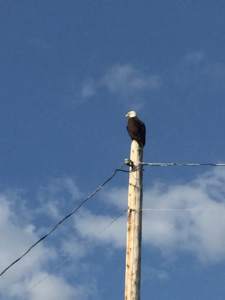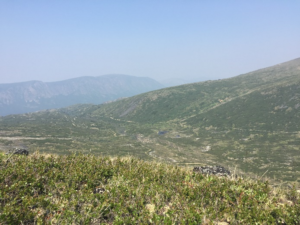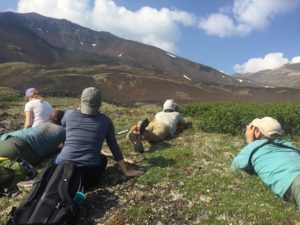Mountain forget-me-not next to a subalpine fir and moss campion on top of Monarch Mountain in Atlin, British Columbia. Photo by Calla Sopko.
By Calla Sopko, University of Vermont
Welcome to the far north! We are starting 6 weeks of conservation research in northern British Colombia for our summer semester in the Taku. Our adventure started off with some light at the end of a long day of travel. As our plane flew into the Whitehorse airport, we were able to watch the sun set at around 12:30 in the morning, which was a bit of a shock to my system – where I’m from the light sets at 8pm!
In the morning, we wandered around Whitehorse, picked up supplies, and then drove south to reach our final destination, Atlin – in British Columbia but just south of the Yukon border – where we would be setting up our base camp. When trying to pick an area to set up our tents, we discovered that right near the house we were calling home base, was a magnificent view of Theresa Island and Atlin Lake. We also got to wander around the town of Atlin, where we even met the resident bald eagle that hangs out on top of one of the poles by the water.

A resident bald eagle sitting at the top of a telephone pole in Atlin, British Columbia. Photo by Calla Sopko.
We got the chance to hike up Monarch Mountain, where we got our first taste of some of the unique alpine species that reside in the mountainous regions. My personal favorite was the mountain forget-me-not because it reminded me a little bit of home, while still serving as a reminder of all of the cool and unique plants that are out there that I haven’t had the chance to see before. The views off of Monarch were incredible and we ended up spending some time at the summit sketching some of the alpine vegetation and views.
While the hike up Monarch Mountain may have felt steep at the time, it was nothing compared to Ruby Mountain, the hike we did the next day. Ruby Mountain is the remnant of a volcano, with loose dirt and rocks covering the sides making the steep climb even more difficult. But the climb was well worth the view. Not only did we get a great view of the surrounding landscape, but we saw several Stone sheep and even a lone Caribou. The Stone sheep were taking advantage of the copious amount of natural salt licks located on the rock in the valley of Ruby Mountain, while the Caribou was lying in the last remnants of snow on a ridge.
The summit holds an old caldera, creating a bowl that holds water and allows alpine plants to flourish. On the hike down we walked along some old mining roads that are visible on the sides of some of the mountains in the area. We got the chance to talk about plaster mining, a common type of mining in the area, which is threatening the environment and the livelihoods of the Tlingit people, the aboriginal people whom have always called Atlin home. The loud blasts from mining have the potential to disturb wildlife in the area, like the Caribou and the Stone sheep, which may have lasting repercussions.

In the distance, the mountains are hazy due to smoke blowing into the area from fires in Alaska. Photo by Calla Sopko.
The next day we set off on another hike. This time we were hiking up a ridge with the goal to look for more ungulates, like the Stone sheep and Caribou we had seen the previous day. On the way up, we passed a red fox peeking up over a hill and watching us as we went by. In the distance there was also a golden eagle soaring in the valley. Both sightings were relatively unique because the wolves typically outcompete red foxes in the area and golden eagles are more uncommon in the area. The two sightings were definitely the highlight of my day! The view from the top of the ridge was pretty hazy by the time we got up there, which was apparently caused by some smoke blowing in from fires in Alaska. Fortunately though, we were still able to get some great views of the patches of snow on the surrounding ridges and we spotted three caribou hanging out and trying to keep cool on a particularly hot day. At the end of the day, we headed over to Warm Bay for a quick swim to cool down in Atlin Lake. While the name may have been deceiving, the swim and subsequent frisbee throwing were well worth the drive up to the hazy bay.
That night we experienced our first rain, but we woke up to a sunny morning and the anticipation of a parade. July 1st is Canada day, or the celebration of the day Canada was formed, and the town of Atlin was having a parade with the promise of cupcakes at the end. We headed into town and saw the highest concentration of dogs that I think I have ever seen in a single place. In every direction there was a different type of dog and they were all friendly and excited to celebrate the day as much as their humans were.
The parade going through Atlin with many dogs hanging out with their owners. Photo by Shalynn Pack.
The parade went down the main road of Atlin and highlighted the different volunteers that have helped to make the town great. The cupcakes at the end were as amazing as I had imagined. Our first few days in Atlin have been full of fun hikes, interesting wildlife, and the chance to explore a new place, and I would have to say it has been a pretty exciting experience so far!


